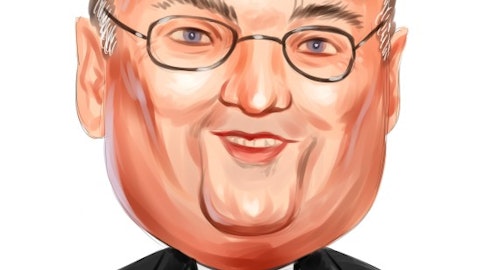Dave Koning: Yes. Hey, guys. Thank you. And I guess my first question on merchant, I think in the first quarter, it’s going to be down slightly, but the full year is down a little more. Could you give a little context on when that might bottom? And then kind of how do you see the longer term and even Payrix, I think it’s been pretty stable through the year. I think it was expected to grow a lot. And just how maybe that’s transpiring as well?
Stephanie Ferris: Yes, I might qualitatively take it, Dave. And if Erik thinks we need more fine points on the numbers that will be good. I think broadly, we would say we have seen in the fourth quarter, obviously continued deterioration from a recession standpoint in the UK. And in the U.S., consistent with what Visa Mastercard talked about a shift from goods to services. And so we have baked in our guide throughout the year, that continued shift. I think Erik just talked about the overall economic impact in merchant to be about 500 basis points. On a positive note, we are seeing a positive January, but we wouldn’t expect to flow that through. So from a broad-based recession standpoint, that’s how we’re thinking about the business.
I think that we just have that continuing throughout 2023. We do think as those recessionary ties reside or come back and with the allocation of more M&A capital, this business can really get back to a mid-single-digit grower and be back in a growth trajectory.
Dave Koning: Alright. Alright. And then and I guess my follow-up kind of along Lisa’s question. The corporate expense of merchant, is there any way just for us to think about what percent of revenue maybe we have to add like 3% of revenue or something when we think of kind of our sum of the parts and everything?
Stephanie Ferris: Yes, not yet, Dave. We will be back out to you on that. I think we have to be thoughtful. I’m not sure we could just come right back into what it was before. And so we will be back to you on that.
Operator: Thank you. And that will come from the line of Jason Kupferberg with Bank of America. Your line is open.
Jason Kupferberg: Good morning, guys. I wanted to start on the Banking side since that obviously the biggest part of the RemainCo. You grew 6% organic down in 2022 and you’re expecting, I guess, about 500 bps of deceleration at the midpoint in 2023. Can you just unpack that a bit? I mean, just considering you’ve got 80% recurring revenue there, somewhat surprising. Thank you.
Erik Hoag: Yes. Hey, good morning. Thanks for the question. So a couple of things hey, good morning. In walking the 22 to 23 number, there is two predominant drivers here. One is the lapping of large deals. So we spent some time in the second quarter, third quarter calls talking about some of the very large deals, total contract value in excess of $50 million. Those deals have elongated, which is driving roughly half of the step down from 22 to 23. And the second is a reduction in non-recurring revenues. Non-recurring revenues predominantly license fees and termination fees, which over the longer term will drive higher recurring revenue and improve the overall health of the banking segment.
Jason Kupferberg: Okay. For my second question, I wanted to go to Merchant for a minute. So if we look at the down 2% to 4% for 2023, can you give us a sense of what you are assuming for enterprise versus e-com versus SMB? Thank you.
Erik Hoag: Yes, sure. So the enterprise sub-segment, which is roughly half the book, down mid single-digits, this is where the UK sits, the SMB sub-segment, down low double-digits. And our e-commerce book continues to perform well, up double-digits.
Operator: Thank you. That will come from the line of Darrin Peller with Wolfe Research. Your line is open.
Darrin Peller: Hi. Thanks guys. If I want to just if we could just follow-up for a minute on the Banking segment and for and frankly, the Cap Markets segment as well, Cap Markets showed strong or Banking. Your guidance is, as you talked about, has some items in it, but help us just touch on the balance between your cost-saving initiatives and the investments you need in that business to really sustain the growth you want it to be in term. I mean I know you have some good assets, whether it’s Modern Banking or PaymentsOne or Digital One or others. But anything you can give us on your conviction level in that business returning to that mid-single digit rate of growth despite where the costs are coming out of will not affect the growth profile?
Stephanie Ferris: Yes. Darrin, happy to take that a little bit. So, in terms of making sure that we have the right amount of investment associated with the revenue, I think the business has benefited over the last 3 years to 5 years from a significant amount of capital investment to deliver some of the best-in-class products you see out there, Modern Banking platform, as you mentioned, PaymentsOne, Digital One, etcetera. All that investment has really played out nicely for us in terms of being in market, driving real recurring revenue growth as we move forward. So, we feel very comfortable around reducing the investments associated with that to what we consider more normal run rate. So, a lot of our reductions and expenses are around capital around one-time.
And then on the operating expense side, as you would expect, we are definitely protecting the business to ensure that we can deliver on the recurring revenue growth, so focused on more infrastructure costs or costs in the functional side of things. We believe very strongly in the ability for this business to have underlying margin expansion. As you know, it has high margin of new business coming on. We believe and are committed to the 3% to 5%. We believe it will reaccelerate in 2024, as Erik said, in terms of the two items really impacting it. So, we feel very good about the underlying revenue growth as well as our ability to continue to expand margins. And our Future Forward initiatives, as we laid out really aren’t about kind of cost cutting or cost cutting sake.
You can see that we are really focused on faster time to market, faster implementations speed, agility, etcetera, and making the engine go faster versus just a flat out reduction of expenses.
Darrin Peller: Okay. Stephanie thanks. Just a quick follow-up on the merchant side of the business. When we think about the growth profile, you are talking about that getting back to, I guess maybe just to revisit the strategy on the SMB side for a moment. And is that an area that you foresee being able to really show an acceleration and/or is it just basically e-com still getting what’s the strategy of the segment?
Stephanie Ferris: Of the overall segment? Yes. So, I think look, the strategy is consistent. I think the challenge for us is because of our lack of M&A, we haven’t really been able to feed it enough product, as the pandemic created some real structural challenges in some of our key segments. So, I would say broadly, we are really focused on continuing to drive more e-commerce into the segment. As you know, we are the largest global acquirer in the world. I think we are the largest e-commerce provider as well. That’s primarily been in the large space. And with the acquisition of Payrix, we now have the ability to move down market and bring not only embedded payments, but also be focused on platforms. So, it’s accessing for us not only large e-commerce clients, but also the small.
So, that continues to be our strategic imperative. As you know, we have some historical businesses in our SMB space that are ISO primarily card-present or the pieces of our ISV book that are structurally impaired in terms of consolidation in retail restaurant software. And so those are pieces of our business that we continue to process for those software providers, but now they would become more like very large enterprises. So, I would say strategically, the payment strategy going forward continues to be focused on e-commerce and omnichannel capabilities, using the global platform and the global distribution capabilities to deliver best-in-class products. I think the challenge for us over the last couple of years is our inability to use M&A, to make sure that we get the best products we need to put across the platform as the end market moves.
Operator: Thank you. Next will come from the line of John Davis with Raymond James. Your line is open.





